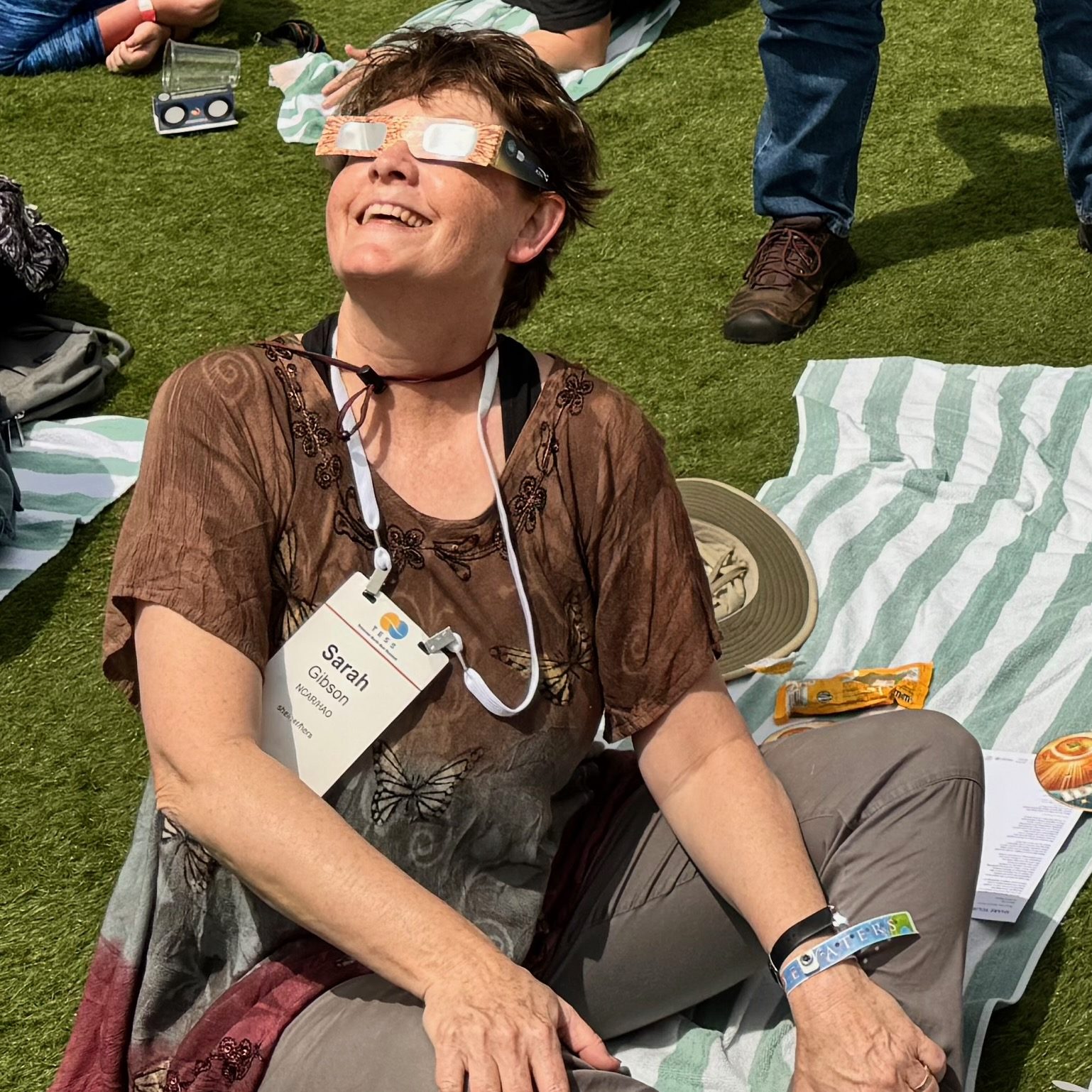About Sirius Travel
Scientist Guides
Sirius Travel Inc. is owned and operated by astronomers whose specialties include solar astronomy, stellar and planetary evolution, galactic astronomy, cosmology, X-ray astronomy, astrophotography, and archaeoastronomy. When we are not leading excursions to interesting astronomical sites in the U.S. or around the world, we pursue observing time, write papers, and teach astronomy. Based in Boulder, Colorado, Sirius Travel is influenced by and ideally situated to access the rich astronomical environment, both ancient and modern, of the north american southwest.
Victoria Alten Sahami
Victoria Alten Sahami, M.S. is an alumna of the University of Colorado astrophysics program and currently teaches astronomy at Metropolitan State University in Denver.
Kamran Sahami
Kamran Sahami, Ph.D. is a professor of physics at the Metropolitan State University of Denver (MSU) and is a researcher at the University of Colorado in Boulder.
Travis Rector
Travis A. Rector, Ph.D. is a professor of astronomy at the University of Alaska Anchorage.
Ken Yanow
Kenneth Yanow, M.S. has graduate degrees in both Astronomy and Geology and has been a Professor of Geographical Sciences at Southwestern College (SWC) for the past 20 years.
Ralph Shuping
Ralph Shuping, Ph.D. continues to work on contract for the SOFIA program as an Observatory Scientist, and is also an Adjunct Professor in the Physics Department at Lewis & Clark College in Portland.
Trina Ray
Trina Ray, M.S. currently works as the Deputy Science Manager and Investigation Scientist for the radar instrument on NASA’s Europa Clipper Mission. She is an active public speaker, invited to give many talks around the nation.
Henry Throop
Henry Throop, Ph.D. is a Program Scientist at NASA HQ in Washington, DC, where he manages NASA’s research programs in the outer solar system.
Aaron Lewis
Aaron D. Lewis, Ph.D. studied clusters of galaxies and dark matter with the Chandra space telescope as well as ground-based observations. He is an outreach volunteer with the Eastbay Astronomical Society, and consultant for a healthcare company.
Timothy Hatchett
Timothy Hatchett, M.S. is an astronomer in the Denver area who is active in Astronomy education and outreach. He is currently teaching science at the Denver School of the Arts.
Sachin Shenoy
Sachin Shenoy, Ph.D. is an astronomer working as a senior research scientist at Space Science Institute (SSI) in Boulder, CO. He will soon start with Space Telescope Science Institute (STScI) where he will join Hubble Space Telscope’s Wide-Field Camera 3 (WFC3) team as a Principal Staff Scientist.
Rich Terrile
Rich Terrile, Ph.D. is an astronomer and the director of the Center for Evolutionary Computation and Automated Design at NASA’s Jet Propulsion Laboratory.
Johannes Loschnigg
Johannes Loschnigg, Ph.D. is an atmospheric and oceanic scientist who has been a faculty research scientist and White House science and technology advisor and currently consults for aerospace and satellite companies.
Clive Ruggles
Clive Ruggles, Ph.D. was the world’s first — and for many years only — Professor of Archaeoastronomy. He is now Emeritus at the University of Leicester.
James Dove
James Dove, Ph.D. has been a professor of physics and astronomy at the Metropolitan State University of Denver since 1999.
Nick Graber
Nick Graber, BA is a science communicator who studied astronomy at Columbia University before spending three years working with telescopes at Cloud Break Optics in Seattle.

Carla Johns
Carla Johns, M.S. in Astronomy & Science Education and M.Ed in Organizational Development, works at Fiske Planetarium at the University of Colorado Boulder. She previously worked at NASA, JPL, Griffith Observatory, and Mt. Wilson Observatory.
John Steele
John Steele, Ph.D. is Professor of the History of the Exact Sciences in Antiquity at Brown University. John’s work focusses on the astronomy of ancient Babylonia, the legacy of Babylonian astronomy in other cultures, and the history of the rediscovery of ancient astronomy since the 18th century.
Kim Steadman
Kim Steadman, M.S., is a science systems engineer at NASA’s Jet Propulsion Laboratory. It is her job to enable science while keeping the Mars rover (Perseverence) safe and happy.
Sarah Gibson
Sarah Gibson, Ph. D. is a Senior Scientist at the National Center for Atmospheric Research (NCAR) where she has served as Section Head, Deputy Director, and Interim Director of NCAR’s High Altitude Observatory.

Todd Barber
Todd J. Barber, M.S., is a propulsion engineer at NASA’s Jet Propulsion Laboratory. Todd has worked exclusively in mission operations for over three decades, including support to the last four Mars rovers, the Europa Clipper project, and the Voyager mission

Erika Gibb
Erika Gibb, Ph.D. is an astronomer and professor at the University of Missouri – St. Louis. She is an expert in comets and young star systems and is very interested in astrobiology and origins of life studies.
Support Staff
Elizabeth Georges
Elizabeth Georges joins us from Argentina and holds a degree in Tourism. She specializes in programming and designing tailor-made tours that cater to the unique interests and preferences of each group.
Kevin Mattaboni
Kevin Mattaboni is an experienced Australian tour operator based in Western Australia. We are happy to have him join our team of hosts for Majorca 2026, Egypt 2027, and Australia in 2028.

Pam Pruett
Pam Pruett is a Sirius Travel tour director when she is not working as a Clinical Laboratory Scientist at a local hospital laboratory. She loves to hike national and state parks with her family, read, knit, and go outside to look at anything happening in the sky.

Kristofer Sahami
Kristofer Sahami interns as a tour guide on our eclipse tours and is currently in training to build and manage new itineraries.

Nikolas Sahami
Nikolas Sahami is a marketing and media coordinator and tour designer. Recently Nikolas has started working as a tour director on our eclipse tours.

Nina Shuping
Nina Shuping is a tour director with a background in science communication and hospitality. She holds a degree in urban planning and currently works in affordable housing research.

Lyn Lane
Lyn Lane is an Office Coordinator and Programmer. Lyn has worked in IT throughout her career and is enjoying the variation of working in the travel industry.
Our Story
Sirius Travel is named for Sirius, the brightest star in the sky. Through time, Sirius has shone faithfully in the winter sky when the nights are their longest. Following Orion, the hunter, Sirius is part of the constellation Canis Major – Orion’s hunting dog – always at the hunter’s knee. Once a year Sirius disappears in the light of the sun only to reappear in the early morning close to the summer solstice.
More than 5000 years ago, the predawn rising of this bright star alerted the ancient Egyptians to the imminent annual flood of the Nile River. The ancient Greeks and Romans thought that Sirius added just enough heat and light to make late summer uncomfortable – hence “dog days”.
Sirius is a bright, white star. Yet there are many references in ancient literature to its redness. Astronomers have been attempting to come up with an explanation for this ‘red’ Sirius anomaly for hundreds of years. Babylonian cuneiform texts, and the writings of classical Greco-Roman authors, including Cicero, Horace, Seneca and Ptolemy, refer consistently to Sirius as a red or reddish star. Seneca (c.25AD) stated the redness of Sirius to be ‘deeper than that of Mars’. Modern astronomers have debated whether Sirius could have changed its intrinsic color from reddish to white in only two millennia. This debate has been on-going for two centuries, but there has been no clear resolution.

Comparing ancient and modern observations, Sirius was the first star to have a discernable proper motion discovered. It moves approximately one degree every 2700 years and, in 1844, a study of its wobbling motion through the sky allowed Friedrich Bessel to deduce the existence of a faint companion around the star. This companion, Sirius B, was discovered visually in 1862 by the lensmaker Alvan Clark and identified as a white dwarf by a spectrum obtained in 1915 with the 60″ telescope at Mt. Wilson Observatory.
Our logo is the symbol for a total solar eclipse as depicted in the Dresden Codex, a collection of Mayan observations and calculations of astronomical phenomena. The symbol is thought to date from circa 600 a.d. and consists of the four-parted k’in, or “day”, sign and a background representing the sun passing through the moon’s shadow at the time of an eclipse.
Since life is circular in nature let us close with this: We chose the name Sirius Travel largely because of it’s double entendre and the fact that it made us chuckle. A little research has led us to recall (because of course we knew at one time) that Sirius B was discovered by Alvan Clark. It so happens that Alvan is the great grand uncle of our tour leader Victoria Alten Sahami. It also happens that Victoria worked at Mt. Wilson Observatory and leads the tours that take people to observe through the 60″ which is the very telescope that was used to identify Sirius B as a white dwarf. Siriusly.





















